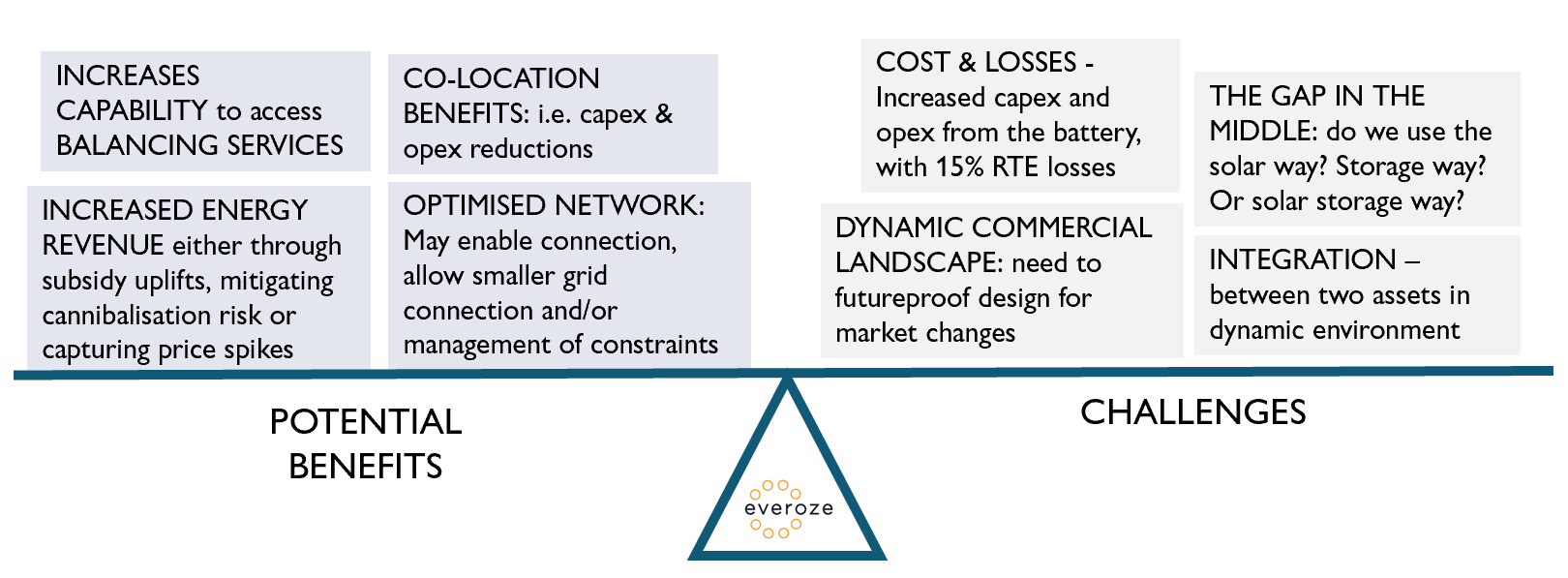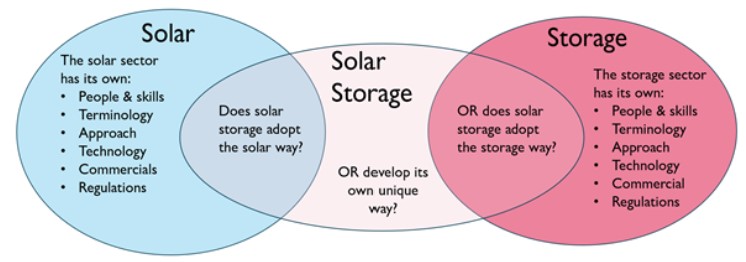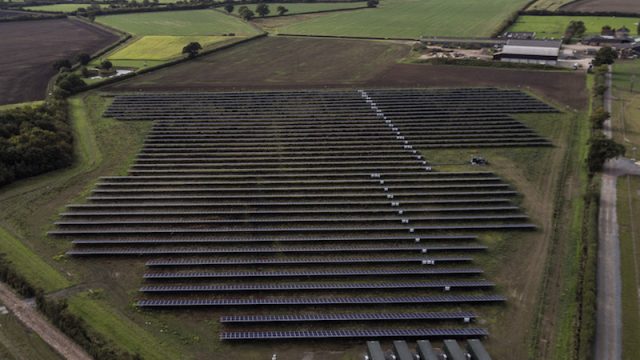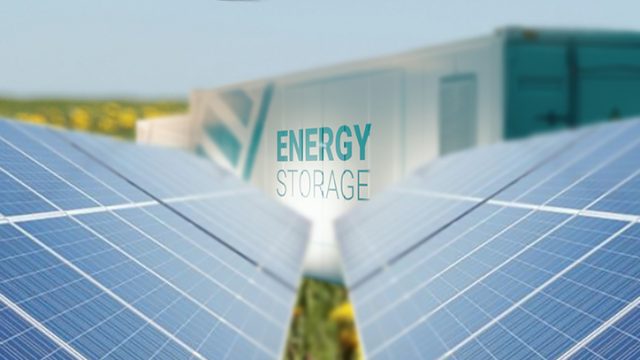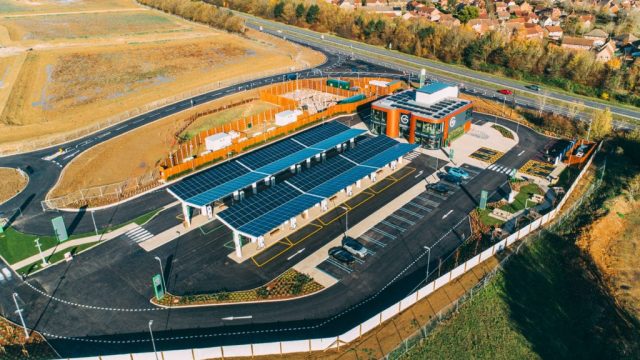The what, the why and the future of solar storage
Published April 2021
The what, why and future of solar storage – a fascinating new blog from Paul Reynolds on this super hot topic.
Solar storage here. Solar storage there. Solar storage everywhere. With all the hype, it is easy to feel that you are missing out. In this blog we help you gain clarity by simply explaining what solar storage is, why it is potentially attractive, and how market changes are making it more so. And we do so in three helpful graphics. The focus is on front of meter utility scale projects in EU markets.
(The analysis is based on insights from due diligence, strategic and project support to solar storage projects in 5 EU countries since 2017, complementing over 20GW’s of work on solar PV and 3GW in battery storage. Recent publications include report on UK flexibility market opportunities for National Grid’s Power Responsive programme, interview on the Portuguese solar storage results here and PV Magazine article on the importance of revenue diversification for French battery projects here.)
What is solar storage?
As you might expect solar storage refers to a project which includes both solar PV and battery storage (usually Li-ion batteries).
You might also see different terms (solar storage, solar and storage, solar PV and battery storage) all of which are used interchangeably. This can be confusing and masks an important difference between solar storage projects.
To address this Everoze proposes the following distinction:
- ‘solar and storage’ is where solar PV and battery storage are on the same site and share grid connection but have limited electrical integration. This means the solar and storage unit will be providing distinct services and be metered separately.
- In contrast ‘solar storage’ refers to a single integrated asset, most likely with the solar and storage asset on the same DC network (DC coupling). With this asset, the unit as a whole provides a set of services, be this selling electricity, providing ancillary services, etc. Metering arrangements reflect this.
To date the industry in Europe has mostly delivered solar and storage projects. Going forward we will see solar storage projects emerge.
A balancing act
Delivering solar storage projects requires navigating the difficult balance between the potential for increased revenue streams (relative to standalone solar projects) and increased cost and complexity.
On the revenue side, there are four primary drivers of solar storage:
1. Increased energy revenue – either through subsidy design (if subsidy available) or if merchant market through mitigating cannibalisation of capture prices and/or capturing system price spikes
2. Increased capability to access balancing services – earning money through provision of services that help balance the system or network. Solar is a flexible asset in its own right, however this capability is increased significantly through the addition of a battery.
3. Optimised network connection – either through enabling connection to the network, reducing the cost of doing so and or helping manage constraints or curtailment.
4. Colocation benefits – two projects on the same site may benefit from reductions in capex and opex costs.
(An interesting fifth one is potential for solar storage to be a hybrid asset class, blending the low risk / low returns of PV with a higher risk / higher returns play for storage. This may allow different funding models to come forward).
In terms of the challenges there are four key challenges:
1. Higher costs and significant energy losses – adding a battery adds significant capex and opex costs, and means ~15% round trip efficiency losses for any energy that goes through the battery. This higher costs and losses clearly need to be offset by increases in revenue.
2. Dynamic commercial landscape – although market dependent, the solar storage revenue landscape is likely be dynamic, with a high chance that the revenue streams a project designs for at the beginning of the project will be different to that which the project will provide at the end of life. There are also lots of alternative ways of delivering balancing services, with solar storage in competition for some revenue streams against standalone batteries, gas peakers, smart EV charging, etc.
3. Integration – once the commercial model has been determined there are then the techno-commercial challenges of delivering an integrated asset. For instance: how do you optimise the grid connection? Is DC coupled the best for the business case? How does storage impact the business case for trackers or east / west layouts? How are EPC contracts and warranties integrated? All questions that need to be worked through, in the context of a dynamic commercial landscape.
4. The gap in the middle – to date solar and storage have been reasonably distinct sectors, each with their own people, terminology and approaches. As shown in the image below, with solar storage there is now the question: does the sector adopt the solar way? The storage way? Or develop a new solar storage way? This applies equally to regulations with solar storage projects may fall outside of tightly bounded regulatory definitions.
Tipping the balance
As we look forward, it is highly likely that the challenges associated with solar storage will reduce, while the benefits increase, tipping the balance towards solar storage.
Regarding challenges, battery and PV prices will continue to fall and the industry will develop tools, techniques and technology that better integrate the two assets. The commercial landscape is unlikely to get any simpler, but there will be new players and approaches to better manage this uncertainty.
At the same time, the benefits from solar storage are likely to increase. With higher penetrations of solar, the capture price cannibalisation risk will become more significant, with solar storage a key mitigant for solar PV developers. Balancing and ancillary services will become more accessible and prices may rise. Perhaps more fundamentally, solar PV projects will need to play a much greater role in helping manage the system they generate into.
All this and you can start to see why the balance may just tip towards solar storage.
If you want support with your solar storage or solar and storage project please email contact@everoze.com


